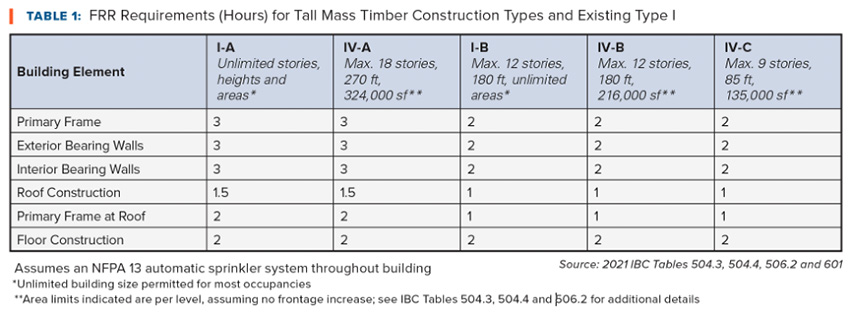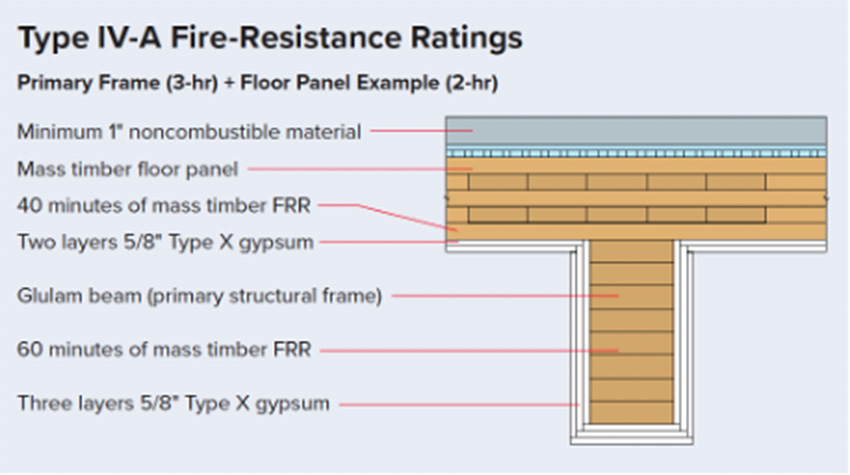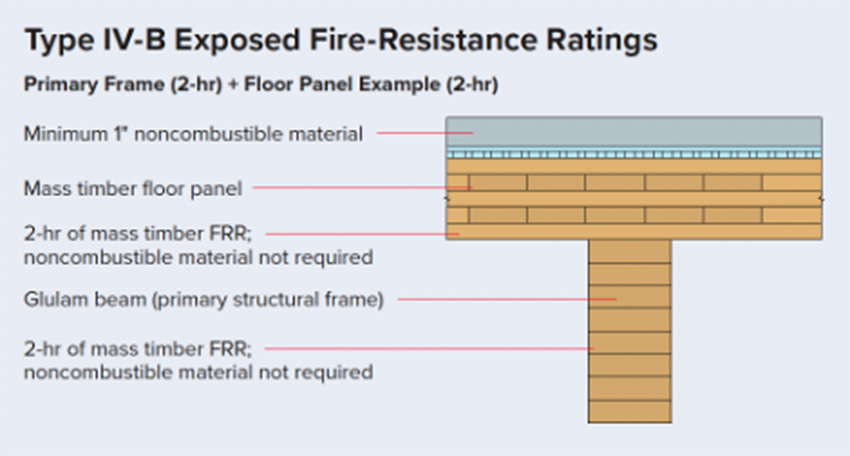THE EVOLUTION OF BUILDING BIGGER AND TALLER WITH WOOD CONSTRUCTION
The built environment in the U.S. is growing at a rapid rate as a result of an ever-rising need for housing and infrastructure. It’s estimated that America is short more than 5 million homes1, and a boost in infrastructure spending is further accelerating new construction2. At the same time, buildings and their construction account for more than a third of global carbon dioxide emissions3, with 11% of carbon emissions generated from the building materials and construction4. This embodied carbon can account for half of the total carbon footprint over the lifetime of a building5.
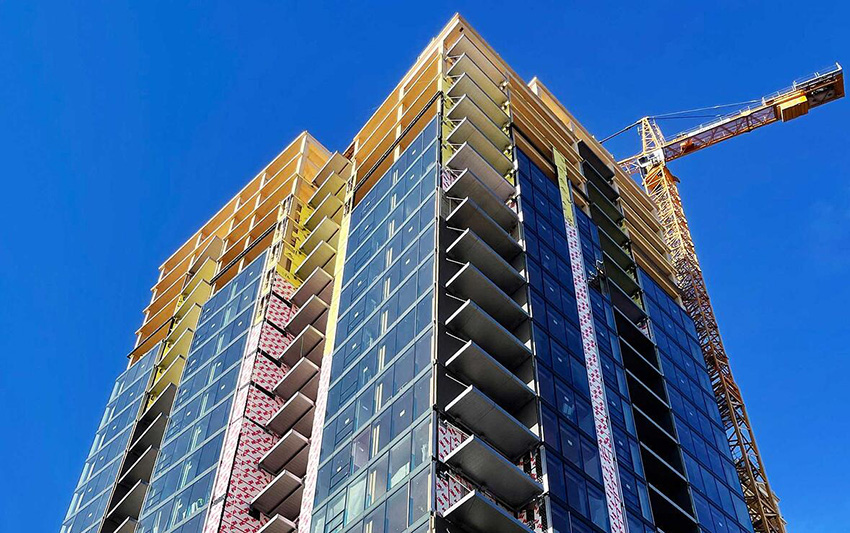
Photo: CD Smith
Ascent in Milwaukee, completed July 2022, is 25 stories tall and constructed from CLT floor panels supported on glulam beams and columns with two reinforced concrete cores by architect Thornton Tomasetti.
To address these concerns, some policymakers6 and design teams7 are turning, in part, to timber—a naturally renewable building material that, being 50% carbon by dry weight8, can lock in carbon over the lifetime of a building9. Product advancements, new capabilities of hybrid-timber construction, fire testing, and fire-resistant designs have all contributed to an increased capacity to build larger and taller buildings using low-carbon wood products.
In this course, you’ll learn about the 2021 International Building Code (IBC) changes related to tall wood construction, including three new building types that allow for wood buildings up to 18 stories10 and even taller using an Alternate Materials and Methods Requests (AMMR)11. Rigorous fire testing was conducted as part of these code changes to validate the safety of tall mass timber construction.
Along with advancements in tall mass timber construction, the course explores design tactics and relevant code applications used to boost the density of light-frame wood construction. Finally, this course will review the science related to wood’s embodied carbon and life-cycle assessment in the context of curbing a building’s impact on climate change, including a growing body of research demonstrating how building with timber represents an opportunity to increase the long-term storage of carbon in today’s built environment12.
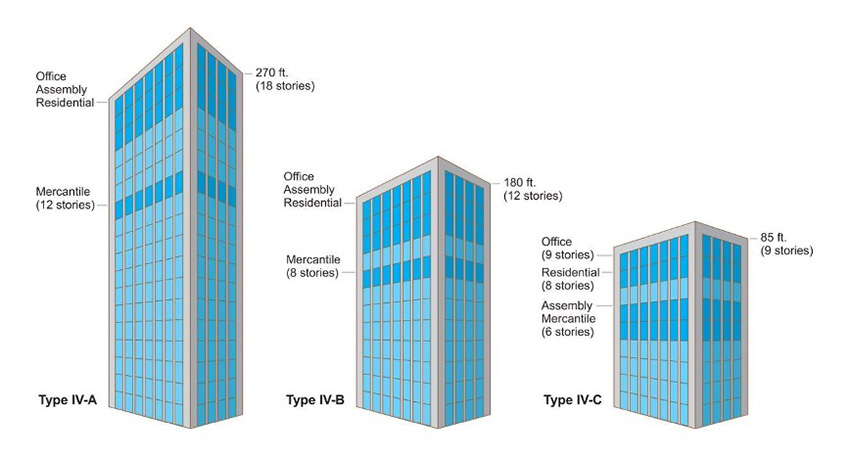
Photo courtesy of WoodWorks
Representative Building Sizes for Business Occupancy.
GLOBAL TREND TOWARDS TALL MASS TIMBER BUILDINGS
Over the past 15 years, there has been a growing interest in tall buildings constructed from mass timber materials. This has been coupled with technical advancements that one architect described as “a timber renaissance, with new milestones in timber construction being reached at a breakneck pace13.” Around the world, there are now dozens of timber buildings constructed above eight stories tall. International examples include Brock Commons in Vancouver, BC (18 stories), Mjøstårnet in Norway (18 stories), and HoHo Wien in Austria (24 stories).
In the United States, such buildings have been constrained by a strong reliance on prescriptive building code limits and less willingness to use performance-based fire protection engineering. That said, mass timber construction has grown significantly, and changes to the 2021 IBC have greatly increased the pace at which new tall mass timber projects are being proposed. As of early 2022, more than 1,300 mass timber projects have been built, are under construction, or in design in the US14; more than 160 of these are considered tall mass timber projects, exceeding the height and/or story limits for mass timber under the 2018 IBC.
THE PATH TO 2021 CODE CHANGES: ICC TALL WOOD BUILDING AD HOC COMMITTEE
In response to the growing interest in tall wood buildings, particularly those constructed from new mass timber materials, the International Code Council (ICC) chartered the Ad Hoc Committee on Tall Wood Buildings (TWB) in December 2015. The purpose of this committee was to “explore the building science of tall wood buildings and investigate the feasibility of and take action on developing code changes for tall wood buildings.” Initial activities included reviewing the technical state of mass timber knowledge and building performance and developing a series of compartment fire tests to test the proposed construction types.
In January 2018, the Committee submitted a set of 14 IBC code change proposals to the ICC 2018 Group A code development process, targeting changes to the 2021 IBC. In January 2019, 3 additional code change proposals were submitted by the TWB as part of the Group B cycle. All 17 code change approvals were approved for inclusion in the 2021 IBC, some as submitted and some with modifications.
Concurrently with the development of the IBC code change proposals, the committee overseeing the code-referenced CLT product standard, ANSI/APA PRG-320 Standard for Performance-Rated Cross-Laminated Timber (PRG-320), responded to the desire by fire service representatives on the TWB for higher assurances of CLT behavior in high-rise construction by incorporating a new required test for adhesives used in CLT production. Passing this test is required for adhesives used in all CLT complying with the 2019 edition of PRG 320, referenced in IBC 2021. This test is based on a 4-hour compartment-like fire test designed “to identify and exclude use of adhesives that permit CLT char layer fall-off resulting in fire regrowth during the cooling phase of a fully developed fire.”
2021 IBC CODE CHANGES FOR WOOD CONSTRUCTION
New Tall Timber Construction Types
In looking at the existing tall wood buildings proposed and built around the country and world, the TWB decided to propose expanding the existing Type IV construction by adding three new sub-types—IV-A, IV-B, and IV-C—and renaming Type IV as Type IV-HT. Similar to the noncombustible construction types I and II, the four “mass timber” construction types are arranged from the highest fire resistance and safety requirements (IV-A) to the lowest (IV-HT).
These three new construction types introduced in the 2021 IBC each have different maximum allowable heights, stories, and areas. Type IV-A allows the greatest height and area and has the most stringent fire protection requirements (e.g., fire-resistance ratings, noncombustible protection, etc.), followed by Types IV-B and IV-C. Conceptually, Type IV-A is similar to the existing construction Type I-A (which requires a fully non-combustible structure), with equal or greater fire-resistance rating requirements and no exposed mass timber.
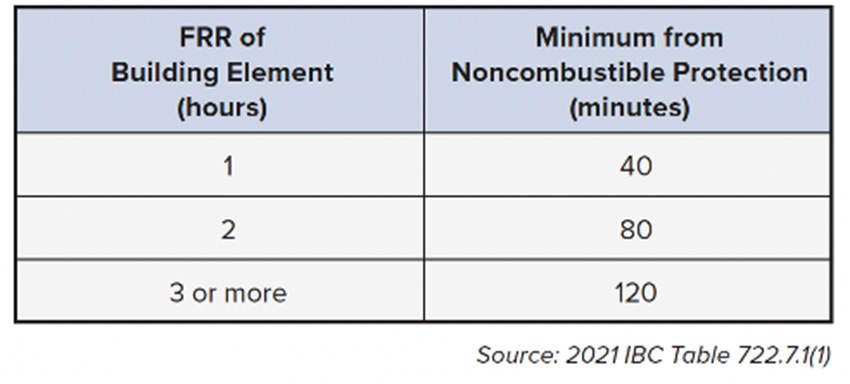
Type IV-C is similar to Type IV-HT with almost all of the interior mass timber permitted to be exposed; however, most structural building components have a 2-hour FRR in addition to minimum heavy timber sizes, resulting in an increase in the allowable number of stories when compared to IV-HT. The TWB also determined that an intermediate construction type between IV-A and IV-C was needed, resulting in Type IV-B. For multi-family occupancies, Type IV-A permits a timber structure of up to 18 stories and 270 feet, Type IV-B permits up to 12 stories and 180 feet, and Type IV-C permits up to 8 stories and 85 feet.
Fire-Resistance Design
A requirement unique to the new construction types is noncombustible protection for some mass timber elements. This noncombustible material applied to the mass timber helps determine fire behavior by delaying the contribution of the mass timber structure in a fire and has an added benefit of increasing the fire-resistance rating of the overall assembly or member. A summary of the fire-resistance rating for the new construction types is shown in the table below. Allowances for Type I-A and I-B are included for comparison.
A provision commonly used in Type I construction for high-rise buildings that do not exceed 420 feet in height allows a reduced FRR if the building has sprinkler control valves equipped with supervisory initiating devices and water-flow initiating devices for each floor (per IBC Section 403.2.1.1). With this provision, the FRR requirements for elements in a Type I-A building may be reduced to the lesser requirements of Type I-B construction (with the exception of columns that support floors), and the requirements for a Type I-B building may be reduced to the lesser requirements of Type II-A construction. These reductions are not available for the new construction types, making them more conservative than Type I requirements.
In addition to meeting FRR requirements, all mass timber elements used in Types IV-A, IV-B, and IV-C construction must meet minimum size criteria prescribed in IBC Section 2304.11.
Definitions of the new construction types (found in IBC Sections 602.4.1, 602.4.2, and 602.4.3) dictate that only mass timber or noncombustible materials can be used for the structural systems. Where mass timber elements are used, the definitions also include guidelines for whether the wood may be exposed on the building’s interior or must be covered with noncombustible protection. General allowances for exposed timber are:
- Type IV-A: No exposed timber permitted
- Type IV-B: Limited exposed timber permitted as follows:
- Ceilings (including integral exposed beams) up to 20% of floor area in dwelling unit or fire area,* or
- Walls (including integral exposed columns) up to 40% of floor area in dwelling unit or fire area,* or
- A combination of each using sum of ratios (actual exposed/allowable exposed wood) not to exceed 1.0
- Type IV-C: All exposed timber permitted*
*Exceptions: No exposed timber is allowed at shaft walls, within concealed spaces, or on the exterior side of exterior walls.
When noncombustible protection is required to cover timber elements, it must provide at least two-thirds of the FRR. For example, a beam that requires a 2-hour FRR and requires noncombustible protection must achieve at least 80 minutes of protection from the noncombustible coverings. Section 722.7, which is new to the 2021 IBC, has been introduced to codify the demonstration of FRR using a combination of time assigned to the noncombustible coverings and inherent fire resistance of the mass timber framing members.
Any noncombustible material used as protection of mass timber elements can be tested by following the procedure outlined in IBC Section 703.6 to determine its contribution to FRR. However, two prescriptive options are presented in IBC 2021 Section 722.7.1. These options are 25 minutes per layer of ½" Type X gypsum board or 40 minutes per layer of 5/8" Type X gypsum board. Using these options, where mass timber is required to have noncombustible protection, two layers of 5/8” Type X gypsum board covering would meet the noncombustible protection requirements for a 2-hour FRR, and three layers would meet the noncombustible protection requirements for a 3-hour FRR.
The remaining one-third of the mass timber member’s FRR must be achieved through inherent fire resistance of the mass timber element. For example, a mass timber floor assembly requiring a 2-hour FRR would require 80 minutes of noncombustible protection, with the remaining 40 minutes achieved from the mass timber. In applications where the timber is exposed, the full FRR must be achieved through inherent fire resistance of the mass timber element.
There are several options for demonstrating the contribution of various elements to the FRR. One method is to provide the results of testing undertaken in accordance with ASTM E119 (or UL 263). However, if the exact assembly has not been tested, IBC Section 703.2 provides a number of alternatives. These alternatives are all founded on ASTM E119 testing. Item 3, which permits the use of calculations in accordance with Section 722, is frequently used to demonstrate the fire-resistance rating of exposed mass timber. IBC Section 722.1 notes that the fire resistance of exposed wood members and wood decking shall be permitted to be calculated in accordance with Chapter 16 of the ANSI/AWC National Design Specification (NDS) for Wood Construction. Chapter 16 of the NDS can be used to calculate up to a 2-hour fire resistance rating for a variety of exposed wood members including solid-sawn, glulam, and CLT.
Hybrid Construction for Shafts & Lateral Resistance
Provisions addressing materials permitted in shaft wall construction can be found in both the shaft enclosures section (713.3) and fire barriers section (707.2) of the IBC. These sections state that shaft walls can be constructed of any material permitted by the building’s type of construction. As noted, construction Types IV-A, IV-B, and IV-C permit the use of mass timber or noncombustible materials (or a combination thereof). This would indicate that the use of mass timber shaft walls in tall buildings is also permitted. This is true with one exception. Section 602.4 of the 2021 IBC notes that shaft walls in buildings taller than 12 stories or 180 feet must be constructed of noncombustible materials. Tall mass timber buildings which do not exceed these limits may utilize mass timber shaft walls; however, those shaft walls must have noncombustible protection on both faces of the wall.
While the code permits the use of mass timber shaft walls in many instances, worth noting is that most tall timber buildings are hybrids, utilizing non-wood materials for shaft enclosures such as concrete cores or steel braced frames with infill light gauge steel stud walls. One of the primary reasons for this is to use these materials as the building’s vertical lateral force resistance system. Until recently, the IBC and referenced standards, such as the American Wood Council’s Special Design Provisions for Wind and Seismic (SDPWS) and ASCE 7 Minimum Design Loads and Associated Criteria for Buildings and Other Structures, did not prescriptively recognize mass timber as an allowable seismic force resisting system. While this did change in the 2021 version of SDPWS and the 2022 version of ASCE with new options for the use of CLT shearwalls, the current provisions limit the overall system height of CLT shearwalls to 65 feet in areas of high seismic hazard. Mass timber vertical lateral force resisting systems have not been implemented to date on tall mass timber buildings in the US, with project design teams choosing to use primarily either concrete cores as shearwalls or structural steel-braced frames.
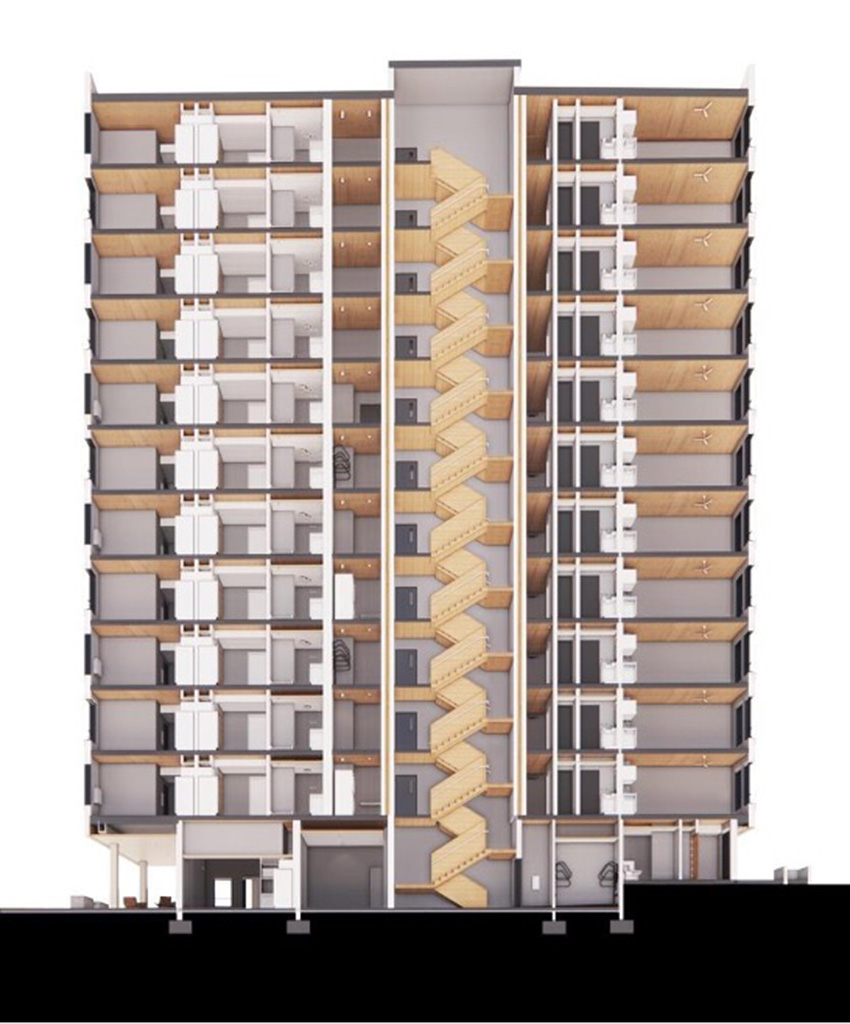
Photo courtesy of Atelier Jones
Type IV-B building with 12 stories.
THE EVOLUTION OF BUILDING BIGGER AND TALLER WITH WOOD CONSTRUCTION
The built environment in the U.S. is growing at a rapid rate as a result of an ever-rising need for housing and infrastructure. It’s estimated that America is short more than 5 million homes1, and a boost in infrastructure spending is further accelerating new construction2. At the same time, buildings and their construction account for more than a third of global carbon dioxide emissions3, with 11% of carbon emissions generated from the building materials and construction4. This embodied carbon can account for half of the total carbon footprint over the lifetime of a building5.

Photo: CD Smith
Ascent in Milwaukee, completed July 2022, is 25 stories tall and constructed from CLT floor panels supported on glulam beams and columns with two reinforced concrete cores by architect Thornton Tomasetti.
To address these concerns, some policymakers6 and design teams7 are turning, in part, to timber—a naturally renewable building material that, being 50% carbon by dry weight8, can lock in carbon over the lifetime of a building9. Product advancements, new capabilities of hybrid-timber construction, fire testing, and fire-resistant designs have all contributed to an increased capacity to build larger and taller buildings using low-carbon wood products.
In this course, you’ll learn about the 2021 International Building Code (IBC) changes related to tall wood construction, including three new building types that allow for wood buildings up to 18 stories10 and even taller using an Alternate Materials and Methods Requests (AMMR)11. Rigorous fire testing was conducted as part of these code changes to validate the safety of tall mass timber construction.
Along with advancements in tall mass timber construction, the course explores design tactics and relevant code applications used to boost the density of light-frame wood construction. Finally, this course will review the science related to wood’s embodied carbon and life-cycle assessment in the context of curbing a building’s impact on climate change, including a growing body of research demonstrating how building with timber represents an opportunity to increase the long-term storage of carbon in today’s built environment12.

Photo courtesy of WoodWorks
Representative Building Sizes for Business Occupancy.
GLOBAL TREND TOWARDS TALL MASS TIMBER BUILDINGS
Over the past 15 years, there has been a growing interest in tall buildings constructed from mass timber materials. This has been coupled with technical advancements that one architect described as “a timber renaissance, with new milestones in timber construction being reached at a breakneck pace13.” Around the world, there are now dozens of timber buildings constructed above eight stories tall. International examples include Brock Commons in Vancouver, BC (18 stories), Mjøstårnet in Norway (18 stories), and HoHo Wien in Austria (24 stories).
In the United States, such buildings have been constrained by a strong reliance on prescriptive building code limits and less willingness to use performance-based fire protection engineering. That said, mass timber construction has grown significantly, and changes to the 2021 IBC have greatly increased the pace at which new tall mass timber projects are being proposed. As of early 2022, more than 1,300 mass timber projects have been built, are under construction, or in design in the US14; more than 160 of these are considered tall mass timber projects, exceeding the height and/or story limits for mass timber under the 2018 IBC.
THE PATH TO 2021 CODE CHANGES: ICC TALL WOOD BUILDING AD HOC COMMITTEE
In response to the growing interest in tall wood buildings, particularly those constructed from new mass timber materials, the International Code Council (ICC) chartered the Ad Hoc Committee on Tall Wood Buildings (TWB) in December 2015. The purpose of this committee was to “explore the building science of tall wood buildings and investigate the feasibility of and take action on developing code changes for tall wood buildings.” Initial activities included reviewing the technical state of mass timber knowledge and building performance and developing a series of compartment fire tests to test the proposed construction types.
In January 2018, the Committee submitted a set of 14 IBC code change proposals to the ICC 2018 Group A code development process, targeting changes to the 2021 IBC. In January 2019, 3 additional code change proposals were submitted by the TWB as part of the Group B cycle. All 17 code change approvals were approved for inclusion in the 2021 IBC, some as submitted and some with modifications.
Concurrently with the development of the IBC code change proposals, the committee overseeing the code-referenced CLT product standard, ANSI/APA PRG-320 Standard for Performance-Rated Cross-Laminated Timber (PRG-320), responded to the desire by fire service representatives on the TWB for higher assurances of CLT behavior in high-rise construction by incorporating a new required test for adhesives used in CLT production. Passing this test is required for adhesives used in all CLT complying with the 2019 edition of PRG 320, referenced in IBC 2021. This test is based on a 4-hour compartment-like fire test designed “to identify and exclude use of adhesives that permit CLT char layer fall-off resulting in fire regrowth during the cooling phase of a fully developed fire.”
2021 IBC CODE CHANGES FOR WOOD CONSTRUCTION
New Tall Timber Construction Types
In looking at the existing tall wood buildings proposed and built around the country and world, the TWB decided to propose expanding the existing Type IV construction by adding three new sub-types—IV-A, IV-B, and IV-C—and renaming Type IV as Type IV-HT. Similar to the noncombustible construction types I and II, the four “mass timber” construction types are arranged from the highest fire resistance and safety requirements (IV-A) to the lowest (IV-HT).
These three new construction types introduced in the 2021 IBC each have different maximum allowable heights, stories, and areas. Type IV-A allows the greatest height and area and has the most stringent fire protection requirements (e.g., fire-resistance ratings, noncombustible protection, etc.), followed by Types IV-B and IV-C. Conceptually, Type IV-A is similar to the existing construction Type I-A (which requires a fully non-combustible structure), with equal or greater fire-resistance rating requirements and no exposed mass timber.

Type IV-C is similar to Type IV-HT with almost all of the interior mass timber permitted to be exposed; however, most structural building components have a 2-hour FRR in addition to minimum heavy timber sizes, resulting in an increase in the allowable number of stories when compared to IV-HT. The TWB also determined that an intermediate construction type between IV-A and IV-C was needed, resulting in Type IV-B. For multi-family occupancies, Type IV-A permits a timber structure of up to 18 stories and 270 feet, Type IV-B permits up to 12 stories and 180 feet, and Type IV-C permits up to 8 stories and 85 feet.
Fire-Resistance Design
A requirement unique to the new construction types is noncombustible protection for some mass timber elements. This noncombustible material applied to the mass timber helps determine fire behavior by delaying the contribution of the mass timber structure in a fire and has an added benefit of increasing the fire-resistance rating of the overall assembly or member. A summary of the fire-resistance rating for the new construction types is shown in the table below. Allowances for Type I-A and I-B are included for comparison.
A provision commonly used in Type I construction for high-rise buildings that do not exceed 420 feet in height allows a reduced FRR if the building has sprinkler control valves equipped with supervisory initiating devices and water-flow initiating devices for each floor (per IBC Section 403.2.1.1). With this provision, the FRR requirements for elements in a Type I-A building may be reduced to the lesser requirements of Type I-B construction (with the exception of columns that support floors), and the requirements for a Type I-B building may be reduced to the lesser requirements of Type II-A construction. These reductions are not available for the new construction types, making them more conservative than Type I requirements.
In addition to meeting FRR requirements, all mass timber elements used in Types IV-A, IV-B, and IV-C construction must meet minimum size criteria prescribed in IBC Section 2304.11.
Definitions of the new construction types (found in IBC Sections 602.4.1, 602.4.2, and 602.4.3) dictate that only mass timber or noncombustible materials can be used for the structural systems. Where mass timber elements are used, the definitions also include guidelines for whether the wood may be exposed on the building’s interior or must be covered with noncombustible protection. General allowances for exposed timber are:
- Type IV-A: No exposed timber permitted
- Type IV-B: Limited exposed timber permitted as follows:
- Ceilings (including integral exposed beams) up to 20% of floor area in dwelling unit or fire area,* or
- Walls (including integral exposed columns) up to 40% of floor area in dwelling unit or fire area,* or
- A combination of each using sum of ratios (actual exposed/allowable exposed wood) not to exceed 1.0
- Type IV-C: All exposed timber permitted*
*Exceptions: No exposed timber is allowed at shaft walls, within concealed spaces, or on the exterior side of exterior walls.
When noncombustible protection is required to cover timber elements, it must provide at least two-thirds of the FRR. For example, a beam that requires a 2-hour FRR and requires noncombustible protection must achieve at least 80 minutes of protection from the noncombustible coverings. Section 722.7, which is new to the 2021 IBC, has been introduced to codify the demonstration of FRR using a combination of time assigned to the noncombustible coverings and inherent fire resistance of the mass timber framing members.
Any noncombustible material used as protection of mass timber elements can be tested by following the procedure outlined in IBC Section 703.6 to determine its contribution to FRR. However, two prescriptive options are presented in IBC 2021 Section 722.7.1. These options are 25 minutes per layer of ½" Type X gypsum board or 40 minutes per layer of 5/8" Type X gypsum board. Using these options, where mass timber is required to have noncombustible protection, two layers of 5/8” Type X gypsum board covering would meet the noncombustible protection requirements for a 2-hour FRR, and three layers would meet the noncombustible protection requirements for a 3-hour FRR.
The remaining one-third of the mass timber member’s FRR must be achieved through inherent fire resistance of the mass timber element. For example, a mass timber floor assembly requiring a 2-hour FRR would require 80 minutes of noncombustible protection, with the remaining 40 minutes achieved from the mass timber. In applications where the timber is exposed, the full FRR must be achieved through inherent fire resistance of the mass timber element.
There are several options for demonstrating the contribution of various elements to the FRR. One method is to provide the results of testing undertaken in accordance with ASTM E119 (or UL 263). However, if the exact assembly has not been tested, IBC Section 703.2 provides a number of alternatives. These alternatives are all founded on ASTM E119 testing. Item 3, which permits the use of calculations in accordance with Section 722, is frequently used to demonstrate the fire-resistance rating of exposed mass timber. IBC Section 722.1 notes that the fire resistance of exposed wood members and wood decking shall be permitted to be calculated in accordance with Chapter 16 of the ANSI/AWC National Design Specification (NDS) for Wood Construction. Chapter 16 of the NDS can be used to calculate up to a 2-hour fire resistance rating for a variety of exposed wood members including solid-sawn, glulam, and CLT.
Hybrid Construction for Shafts & Lateral Resistance
Provisions addressing materials permitted in shaft wall construction can be found in both the shaft enclosures section (713.3) and fire barriers section (707.2) of the IBC. These sections state that shaft walls can be constructed of any material permitted by the building’s type of construction. As noted, construction Types IV-A, IV-B, and IV-C permit the use of mass timber or noncombustible materials (or a combination thereof). This would indicate that the use of mass timber shaft walls in tall buildings is also permitted. This is true with one exception. Section 602.4 of the 2021 IBC notes that shaft walls in buildings taller than 12 stories or 180 feet must be constructed of noncombustible materials. Tall mass timber buildings which do not exceed these limits may utilize mass timber shaft walls; however, those shaft walls must have noncombustible protection on both faces of the wall.
While the code permits the use of mass timber shaft walls in many instances, worth noting is that most tall timber buildings are hybrids, utilizing non-wood materials for shaft enclosures such as concrete cores or steel braced frames with infill light gauge steel stud walls. One of the primary reasons for this is to use these materials as the building’s vertical lateral force resistance system. Until recently, the IBC and referenced standards, such as the American Wood Council’s Special Design Provisions for Wind and Seismic (SDPWS) and ASCE 7 Minimum Design Loads and Associated Criteria for Buildings and Other Structures, did not prescriptively recognize mass timber as an allowable seismic force resisting system. While this did change in the 2021 version of SDPWS and the 2022 version of ASCE with new options for the use of CLT shearwalls, the current provisions limit the overall system height of CLT shearwalls to 65 feet in areas of high seismic hazard. Mass timber vertical lateral force resisting systems have not been implemented to date on tall mass timber buildings in the US, with project design teams choosing to use primarily either concrete cores as shearwalls or structural steel-braced frames.

Photo courtesy of Atelier Jones
Type IV-B building with 12 stories.
TRENDS FOR INCREASED DENSITY IN LIGHT WOOD-FRAME
Although not specific to a change within the 2021 IBC, the past several years have continued to see an increasing trend of light wood-frame projects using innovative approaches to achieve greater density, site utilization, and value. Several examples of how this has been done include more incorporation of amenity spaces (roof decks, fitness centers, retail) as well as on-site parking, all located within the same building. Below is a discussion of the code provisions and design methodologies implemented to achieve these innovative projects.
For years, the IBC has allowed light wood-frame buildings up to five stories for residential occupancies (and six stories for office use) over a single-level podium. The 2015 IBC evolved to recognize multi-level podiums, which had been permitted in the Seattle Building Code for some time. Across the country, designers began maximizing the value of their midrise projects with 5-over-2 and 5-over-3 configurations; however, for one Sacramento project called 1430 Q, 5-over-2 still wasn’t sufficient to make the investment in pencil out. Sacramento’s competitive building market required that 1430 Q have at least six floors of wood-frame residential units to make the project profitable, in a 6-over-2 configuration. By using the City’s Alternate Means and Materials Request (AMMR) process, the design team was able to successfully achieve the extra height and, in so doing, build the country’s tallest light wood-frame building. Several additional projects in Sacramento, which are currently under construction, have been permitted and are using a similar 6-over-2 approach.
In Washington, six stories of Type IIIA construction are permitted when certain criteria are met. Two example projects which are leveraging these code allowances are called Analog and Moraine, both of which are located in Tacoma.


